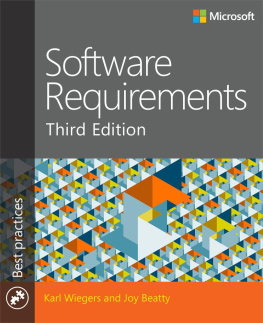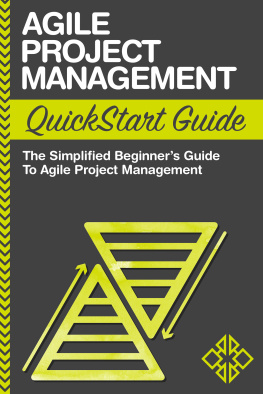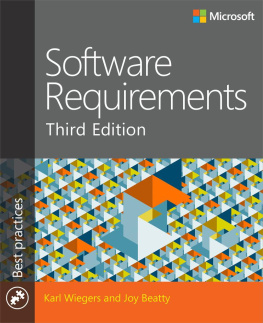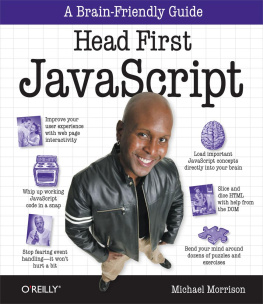Software Requirements
Karl E Wiegers
Joy Beatty
Published by Microsoft Press
For Chris, yet again. Eighth times the charm.
K.W.
For my parents, Bob and Joanne, for a lifetime of encouragement.
J.B.
Introduction
).
The second edition of Software Requirements was published 10 years prior to this one. Ten years is a long time in the technology world. Many things have changed in that time, but others have not. Major requirements trends in the past decade include:
The recognition of business analysis as a professional discipline and the rise of professional certifications and organizations, such as the International Institute of Business Analysis and the International Requirements Engineering Board.
The maturing of tools both for managing requirements in a database and for assisting with requirements development activities such as prototyping, modeling, and simulation.
The increased use of agile development methods and the evolution of techniques for handling requirements on agile projects.
The increased use of visual models to represent requirements knowledge.
So, what hasnt changed? Two factors contribute to keeping this topic important and relevant. First, many undergraduate curricula in software engineering and computer science continue to underemphasize the importance of requirements engineering (which encompasses both requirements development and requirements management). And second, those of us in the software domain tend to be enamored with technical and process solutions to our challenges. We sometimes fail to appreciate that requirements elicitationand much of software and systems project work in generalis primarily a human interaction challenge. No magical new techniques have come along to automate that, although various tools are available to help geographically separated people collaborate effectively.
We believe that the practices presented in the second edition for developing and managing requirements are still valid and applicable to a wide range of software projects. The creative business analyst, product manager, or product owner will thoughtfully adapt and scale the practices to best meet the needs of a particular situation. Newly added to this third edition are a chapter on handling requirements for agile projects and sections in numerous other chapters that describe how to apply and adapt the practices in those chapters to the agile development environment.
Software development involves at least as much communication as it does computing, yet both educational curricula and project activities often emphasize the computing over the communication aspect. This book offers dozens of tools to facilitate that communication and to help software practitioners, managers, marketers, and customers apply effective requirements engineering methods. The techniques presented here constitute a tool kit of mainstream good practices, not exotic new techniques or an elaborate methodology that purports to solve all of your requirements problems. Numerous anecdotes and sidebars present storiesall truethat illustrate typical requirements-related experiences; you have likely had similar experiences. Look for the true stories icon, like the one to the left, next to real examples drawn from many project experiences.
Since the first edition of this book appeared in 1999, we have each worked on numerous projects and taught hundreds of classes on software requirements to people from companies and government agencies of all sizes and types. Weve learned that these practices are useful on virtually any project: small projects and large, new development and enhancements, with local and distributed teams, and using traditional and agile development methods. The techniques apply to hardware and systems engineering projects, too, not just software projects. As with any other technical practice, youll need to use good judgment and experience to learn how to make the methods work best for you. Think of these practices as tools to help ensure that you have effective conversations with the right people on your projects.
Benefits this book provides
Of all the software process improvements you could undertake, improved requirements practices are among the most beneficial. We describe practical, proven techniques that can help you to:
Write high-quality requirements from the outset of a project, thereby minimizing rework and maximizing productivity.
Deliver high-quality information systems and commercial products that achieve their business objectives.
Manage scope creep and requirements changes to stay both on target and under control.
Achieve higher customer satisfaction.
Reduce maintenance, enhancement, and support costs.
Our objective is to help you improve the processes you use for eliciting and analyzing requirements, writing and validating requirements specifications, and managing the requirements throughout the software product development cycle. The techniques we describe are pragmatic and realistic. Both of us have used these very techniques many times, and we always get good results when we do.
Who should read this book
Anyone involved with defining or understanding the requirements for any system that contains software will find useful information here. The primary audience consists of individuals who serve as business analysts or requirements engineers on a development project, be they full-time specialists or other team members who sometimes fill the analyst role. A second audience includes the architects, designers, developers, testers, and other technical team members who must understand and satisfy user expectations and participate in the creation and review of effective requirements. Marketers and product managers who are charged with specifying the features and attributes that will make a product a commercial success will find these practices valuable. Project managers will learn how to plan and track the projects requirements activities and deal with requirements changes. Yet another audience is made up of stakeholders who participate in defining a product that meets their business, functional, and quality needs. This book will help end users, customers who procure or contract for software products, and numerous other stakeholders understand the importance of the requirements process and their roles in it.
Looking ahead
This book is organized into five parts..
concludes by describing how requirements affect other aspects of project work.
New to this edition, contains chapters that recommend the most effective requirements approaches for various specific classes of projects: agile projects developing products of any type, enhancement and replacement projects, projects that incorporate packaged solutions, outsourced projects, business process automation projects, business analytics projects, and embedded and other real-time systems.
The principles and practices of requirements management are the subject of concludes with a description of commercial tools that can enhance the way your teams conduct both requirements development and requirements management.
The final section of this book, can help you select areas that are ripe for improvement. Two other appendices present a requirements troubleshooting guide and several sample requirements documents so you can see how the pieces all fit together.
Case studies
To illustrate the methods described in this book, we have provided examples from several case studies based on actual projects, particularly a medium-sized information system called the Chemical Tracking System. Dont worryyou dont need to know anything about chemistry to understand this project. Sample discussions among participants from the case studies are sprinkled throughout the book. No matter what kind of software your organization builds, youll be able to relate to these dialogs.








